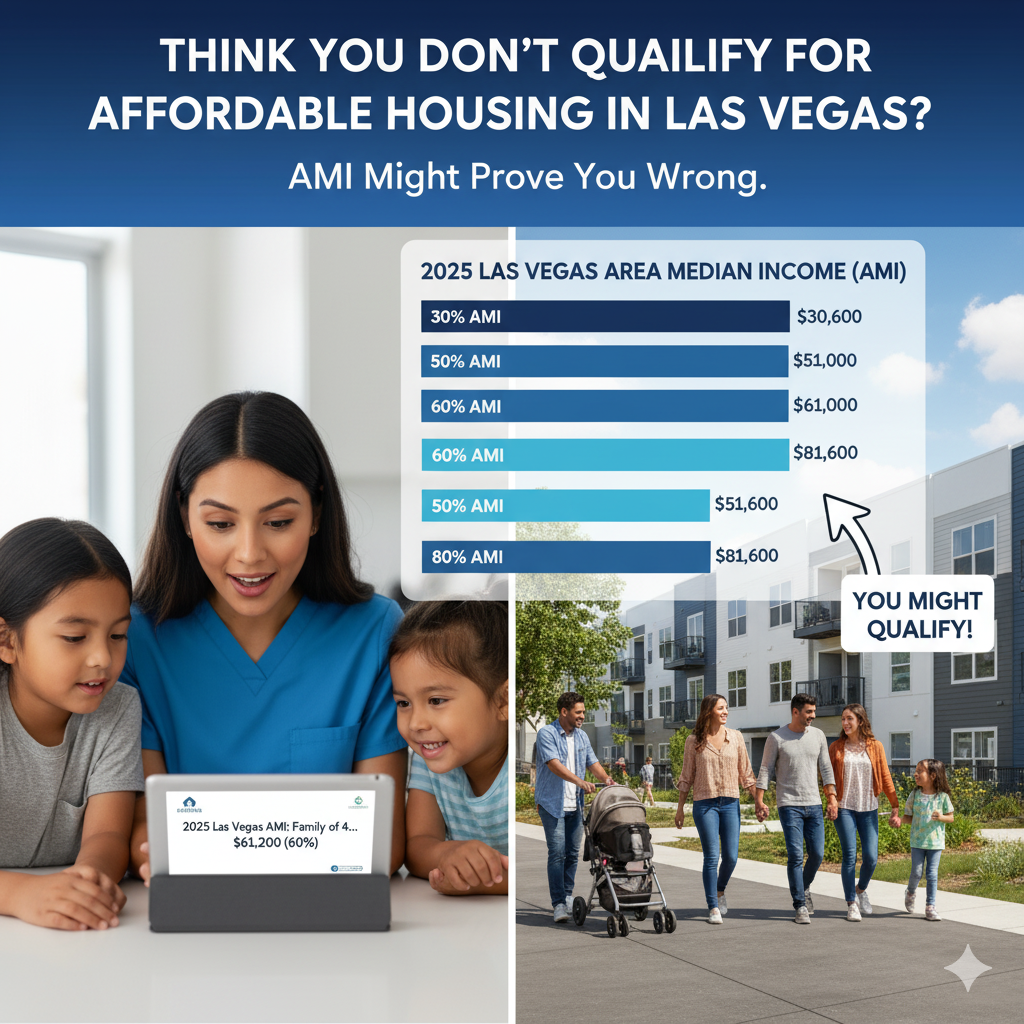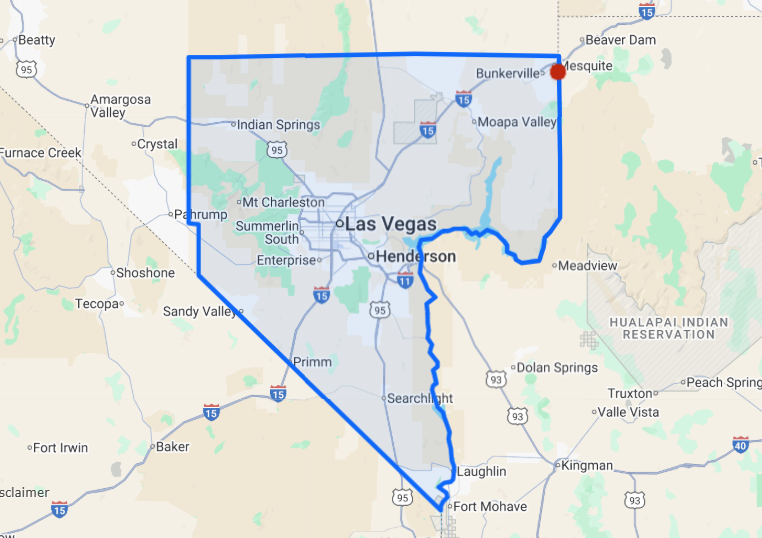Categories
SellingPublished October 24, 2025
Think You Don't Qualify for Affordable Housing in Las Vegas

Think You Don't Qualify for Affordable Housing in Las Vegas? AMI Might Prove You Wrong.
Maria opens another rejection email.
Too much income for housing assistance. Not enough for Las Vegas rent prices.
She's a full-time pharmacy technician. Her husband manages a retail store. Combined, they pull in $58,000 a year. Two kids. A tight budget. Every apartment within reach is either sketchy or slipping away to higher bidders.
She assumes she's stuck in the middle. Makes too much for help. Makes too little for comfort.
Then a coworker mentions something called "60% AMI housing."
Maria Googles it. Finds a number: $61,200 for a family of four.
Wait. She's under that.
Suddenly, programs she thought were reserved for "other people" are actually open to her family. Income-restricted apartments with reasonable rents. Developments near good schools. Waitlists she can actually join.
The difference? Area Median Income. Three letters that unlocked options she didn't know existed.
If you've ever assumed you don't qualify for affordable housing in Las Vegas, the 2025 AMI figures might prove you wrong. Because "affordable" isn't just for the lowest earners. It's a ladder with multiple rungs—and your household might be standing on one of them right now.
What is Area Median Income (AMI) and Why It Matters in Las Vegas
Area Median Income is the household income figure that sits at the exact middle of all incomes in a region—half earn more, half earn less. The U.S. Department of Housing and Urban Development (HUD) calculates AMI annually for every metropolitan area, including the Las Vegas–Henderson–North Las Vegas MSA, which covers all of Clark County. These numbers become the foundation for determining who qualifies for federal, state, and local affordable housing programs.
AMI Definition: The midpoint household income for a region, used to set eligibility thresholds for affordable housing programs. Think of it as a measuring stick, not a finish line.
How HUD Calculates AMI in 2025
HUD starts with U.S. Census Bureau data from the American Community Survey, then applies an inflation adjustment factor based on national per capita wage and salary growth. For FY2025, that factor was 8.04%, reflecting strong wage increases across the country.
To prevent dramatic swings, HUD applies caps and floors—income limits can't increase more than approximately 9% or decrease more than 5% year-over-year. This protects program stability while keeping limits responsive to economic conditions.
Household size matters significantly. HUD scales income limits for families of 1 to 8+ persons. A single person at 50% AMI has a different dollar threshold than a family of four at 50% AMI, because larger households have higher baseline costs. The four-person household serves as the baseline from which other household sizes are calculated.
For the complete methodology and calculations, see the official FY2025 data published by HUD.
Las Vegas–Henderson–North Las Vegas MSA Coverage
The AMI figures apply to the entire Las Vegas–Henderson–North Las Vegas Metropolitan Statistical Area, which includes all of Clark County. Whether you live in Summerlin, Henderson, North Las Vegas, or Boulder City, the same income limits determine your eligibility for affordable housing programs. This means residents throughout the metro area have access to the same programs and thresholds, regardless of which city or unincorporated area they call home.

"One MSA = One Set of AMI Limits"
The Official 2025 AMI Income Limits for Clark County
For 2025, HUD set the 100% Area Median Income for a four-person household in the Las Vegas MSA at $102,000. From that baseline, all other percentages and household sizes are calculated using standardized formulas.
AMI Income Limits Table (1–4 Person Households)
| Household Size | 30% AMI (Extremely Low) |
50% AMI (Very Low) |
60% AMI (Low HOME) |
80% AMI (Low) |
100% AMI | 120% AMI* |
|---|---|---|---|---|---|---|
| 1 Person | $21,450 | $35,700 | $42,840 | $57,150 | $71,437 | $85,724 |
| 2 Persons | $24,500 | $40,800 | $48,960 | $65,300 | $81,625 | $97,950 |
| 3 Persons | $27,550 | $45,900 | $55,080 | $73,450 | $91,812 | $110,174 |
| 4 Persons | $30,600 | $51,000 | $61,200 | $81,600 | $102,000 | $122,400 |
*120% AMI is used for limited programs such as CDBG-DR disaster recovery initiatives.
Source: HUD FY2025 Adjusted HOME Income Limits, effective June 1, 2025
2025 AMI Income Tiers for a 4-Person Household
Clark County, Nevada
These aren't arbitrary cutoffs. Each percentage tier corresponds to specific housing programs and development requirements. Knowing where your household falls on this spectrum tells you which programs to explore first and which properties might have openings that match your income level.
How AMI Unlocks Affordable Housing Programs
AMI percentages act as eligibility gates for different types of affordable housing assistance. Some programs target extremely low-income households at 30% AMI, while others serve working families up to 80% AMI. Here's how the three largest affordable housing programs in Clark County use these thresholds to determine who qualifies.
LIHTC: The Engine of Affordable Apartments (50–60% AMI)
The Low-Income Housing Tax Credit (LIHTC) program is the primary driver of private affordable housing development in the United States. In Nevada, LIHTC is administered by the Nevada Housing Division, which allocates tax credits to developers who commit to reserving units for households earning 50% or 60% of AMI.
For a four-person household in Las Vegas, that means earning $51,000 or less (50% AMI) or $61,200 or less (60% AMI). Recent Clark County LIHTC developments include North & Valley in North Las Vegas (105 units serving 50–60% AMI residents) and partnerships between SNRHA and the Michaels Organization, such as Duncan and Edwards and 28th and Sunrise, which serve households ranging from 30–80% AMI.
Many affordable housing developments using LIHTC in the Las Vegas–Henderson–North Las Vegas MSA set income limits at 40–60% of AMI, as defined by HUD for the metro area in 2025. These properties offer market-quality apartments with amenities, but reserve them for income-qualifying households.
🏢 LIHTC Eligibility: Household income ≤ 50% or 60% AMI, depending on the specific development and unit mix.
HOME Program: Deeply Affordable Units (≤50% AMI, Rent Limits)
The HOME Investment Partnerships Program is a federal block grant supported by the Clark County Welcome Home fund to create and preserve affordable housing for very low-income households. HOME specifically targets households at or below 50% AMI, with strict rent caps to ensure deep affordability.
For 2025, a two-bedroom HOME-funded unit in Las Vegas has a maximum rent of $1,147 per month (not including utilities). This ensures families earning at the 50% AMI threshold don't pay more than 30% of their income toward rent.
Clark County's Welcome Home initiative has invested nearly $250 million since 2022, creating approximately 5,300 affordable rental units throughout the metro area. The program prioritizes reducing planned 60% AMI units down to 50% or even 30% AMI to serve the county's most vulnerable residents, including extremely low-income families and seniors.
In the Las Vegas–Henderson–North Las Vegas MSA, HUD's FY2025 four-person 50% AMI threshold is $51,000, which qualifies households for HOME-funded affordable housing and ensures rent limits remain tied to affordability standards.
🏠 HOME Eligibility: Household income ≤ 50% AMI; maximum rent limits enforced to protect affordability.
Section 8 Vouchers: Rental Assistance for Residents (≤50% AMI)
The Housing Choice Voucher program—commonly called Section 8—is managed by the Southern Nevada Regional Housing Authority (SNRHA) and provides direct rental assistance to very low-income households. Eligibility is generally limited to households earning 50% of AMI or less, with priority given to extremely low-income households at 30% AMI.
For a family of four in 2025, the maximum income to qualify is $51,000. SNRHA serves approximately 13,000 Clark County residents through vouchers, with another 44,000 households currently on waiting lists.
Qualified families typically pay about 30% of their adjusted income toward rent, with SNRHA covering the difference between the tenant payment and the approved rent amount. This allows families to afford housing in the private market while keeping rent burdens manageable.
The Southern Nevada Regional Housing Authority administers Section 8 vouchers using the HUD 50% AMI income limits to qualify low-income households throughout Clark County. Voucher holders can search for housing anywhere in the metro area, including Las Vegas, Henderson, and North Las Vegas.
🎟️ Section 8 Eligibility: Household income ≤ 50% AMI; voucher covers the gap between tenant payment (30% of income) and approved rent.
Who Qualifies for Income-Restricted Housing?
Qualifying for income-restricted housing boils down to three core factors: your household size, your gross annual income, and the program's specific AMI threshold. Understanding how to compare your household's income to the AMI table is the first step toward determining eligibility.
Eligibility Checklist—Do You Qualify?
✅ Step 1: Count Your Household
Include everyone who will live in the unit: adults, children, and any dependents. Household size determines which income column you'll use in the AMI table. Don't exclude children or non-working household members—they count toward your household size.
✅ Step 2: Calculate Gross Annual Income
Add up all income before taxes and deductions. Include wages, salaries, Social Security benefits, pensions, child support, alimony, unemployment benefits, and other recurring income sources. Do not subtract taxes, retirement contributions, health insurance premiums, or other deductions.
Important: Gross annual income (before taxes) is used for AMI eligibility calculations. Programs verify income with pay stubs, tax returns, bank statements, and employer verification letters.
✅ Step 3: Compare to the AMI Table
Find your household size row in the table above, then locate the program's AMI column (30%, 50%, 60%, or 80%). If your gross annual income is at or below that figure, you meet the income threshold for that program tier.
✅ Step 4: Gather Required Documentation
Most affordable housing programs require proof of income and household composition. Prepare recent pay stubs (typically 2–3 months), your most recent tax return, current bank statements, photo identification for all adult household members, and birth certificates or other documentation for dependents.
✅ Step 5: Apply to Specific Developments or Programs
Income-restricted properties accept applications individually—there's no single "affordable housing application" for all properties. Some developments maintain waitlists, while others use lottery systems when openings occur. Apply early and to multiple properties to improve your chances of securing a unit.
Finding Housing Beyond Las Vegas: Henderson, North Las Vegas, and More
Because the entire Las Vegas–Henderson–North Las Vegas MSA shares a single set of AMI figures, residents throughout Clark County have access to the same income limits and program eligibility standards. Whether you're searching in Henderson, North Las Vegas, Boulder City, or unincorporated areas of the county, the 2025 thresholds apply uniformly across all jurisdictions.
This consistency simplifies the qualification process significantly. A four-person household earning $58,000 qualifies for 60% AMI housing whether they apply for a property in Summerlin, Henderson's Green Valley neighborhood, North Las Vegas near Nellis, or any other location within Clark County.
Recent affordable developments have emerged across the metro area, including senior housing communities like Heirloom at Pebble and Silver Desert Estates, as well as family-focused properties in North Las Vegas such as North & Valley. The Clark County Community Housing Fund actively supports affordable housing projects throughout the region, ensuring opportunities exist beyond the Las Vegas city limits.
What Changed from 2024 to 2025?
AMI limits increased by approximately 7.1% to 7.2% across all income tiers from 2024 to 2025—one of the more substantial year-over-year increases in recent years. This expansion broadened eligibility for thousands of Clark County households who previously fell just above qualification thresholds.
Quick Comparison (4-Person Household):
-
50% AMI: $47,600 (2024) → $51,000 (2025) = +7.14% increase
-
60% AMI: $57,120 (2024) → $61,200 (2025) = +7.14% increase
-
80% AMI: $76,150 (2024) → $81,600 (2025) = +7.16% increase
This significant increase reflects HUD's methodological shift from using the Consumer Price Index to using per capita wage and salary growth as the inflation adjustment factor. The 2025 adjustment factor of 8.04% captured strong wage growth across the country, particularly in service sectors.
For Clark County residents, this change means households that previously earned slightly too much to qualify for affordable housing programs may now fall within eligibility ranges. Additionally, rent limits for HOME-funded properties and other programs increased proportionally, helping keep pace with market rent pressures.
Frequently Asked Questions: AMI, Rent Limits, and Vouchers
Q: What is the 2025 Area Median Income (AMI) for a 4-person household in Las Vegas?
For 2025, the 100% AMI for a four-person household in the Las Vegas–Henderson–North Las Vegas MSA is $102,000.
Q: How do I know if I qualify for 60% AMI housing in Clark County?
For a four-person household in 2025, you qualify if your annual household income is at or below $61,200. Adjust this amount based on your specific household size using the table above.
Q: Is "income-restricted" the same as "affordable" housing?
Income-restricted housing is a specific type of affordable housing where eligibility is strictly limited to households earning below a certain percentage of Area Median Income. All income-restricted housing is affordable, but not all affordable housing has income restrictions.
Q: Who sets the AMI limits and how often do they change?
The U.S. Department of Housing and Urban Development (HUD) calculates and updates AMI limits annually, typically releasing new figures in the spring and making them effective June 1st of each year.
Q: What are the 2025 rent limits for a HOME-funded apartment in Las Vegas?
In 2025, the maximum rent for a two-bedroom HOME-funded unit is $1,147 per month (not including utilities). Rent limits vary by bedroom count and are updated annually to align with AMI changes.
Q: What income level is needed to qualify for Section 8 vouchers in Las Vegas?
Eligibility for the Section 8 Housing Choice Voucher program administered by SNRHA is generally limited to households earning at or below 50% of the Area Median Income. Priority is given to extremely low-income households at 30% AMI.
Q: What does "30% AMI" mean for a single person in 2025?
For a single person in Clark County, the 30% AMI threshold (also called "Extremely Low Income") is $21,450 per year in gross annual income.
Q: Do I count my gross income or net income for AMI eligibility?
Housing programs use your household's gross annual income—income before taxes, retirement contributions, and other deductions—when determining AMI eligibility.
Q: Can I qualify for affordable rental housing if I currently own a home?
Generally, affordable rental housing programs serve non-homeowners. However, some homeownership assistance programs (such as down payment assistance or first-time homebuyer programs) do use AMI thresholds to determine eligibility for purchase assistance.
Q: Where can I find income-restricted apartments in Henderson or North Las Vegas?
The same Clark County AMI limits apply to all cities within the metro area. Search for properties through the Nevada Housing Division website, SNRHA's housing portal, or affordable housing locator tools that cover the Las Vegas metropolitan area.
Q: What's the difference between 50% AMI and 80% AMI eligibility?
50% AMI is classified as "Very Low Income" and qualifies households for programs like Section 8 vouchers and HOME-funded housing. 80% AMI is classified as "Low Income" and is the upper limit for programs like CDBG and some public housing initiatives.
Q: How long are waitlists for affordable housing in Las Vegas?
Waitlist times vary significantly by property and program. Section 8 vouchers currently have approximately 44,000 households on the waiting list, while individual LIHTC developments may use lottery systems or maintain shorter property-specific waitlists.
Fair Housing & Compliance Reminders
✅ Eligibility is determined by income and household size only. The Fair Housing Act protects against discrimination based on race, color, national origin, religion, sex, familial status, and disability. Income-restricted housing programs use objective, verifiable income criteria.
✅ This content is educational and informational. It describes publicly available program requirements and AMI data published by HUD. This information does not constitute legal advice, financial advice, or a guarantee of program availability or acceptance.
✅ Income and household verification required. All eligibility determinations require documentation verified by the administering agency or property owner. Prepare to provide pay stubs, tax returns, bank statements, and identification documents.
✅ Programs and limits change annually. While this article reflects 2025 data accurate as of publication, always confirm current income limits, rent restrictions, and program availability with official sources before applying.
For additional information about affordable housing programs and current income limits, consult these official resources:
Next Steps: Explore Your Options
Understanding AMI is the first step. The next is matching your household's specific income and needs to the right programs and available properties.
Curious how these AMI tiers apply to your situation? Whether you're earning $45,000 as a couple or $75,000 as a family of four, there may be affordable housing options available that you haven't considered. The 2025 income limits expanded eligibility for thousands of Clark County households—and yours might be one of them.
Start by identifying where your household falls on the AMI table above. Then explore properties and programs that serve your income tier. Whether you're looking in Las Vegas, Henderson, North Las Vegas, or anywhere else in Clark County, knowing where you stand on the AMI ladder opens doors you might not have realized were there.
Let's walk through your household size, income, and housing goals to explore which affordable housing programs and properties might be the right fit for your family.
This article provides educational information about Area Median Income and affordable housing program eligibility in Clark County, Nevada. All data sourced from HUD FY2025 official publications. For personalized guidance, consult with housing counselors, program administrators, or qualified real estate professionals.






